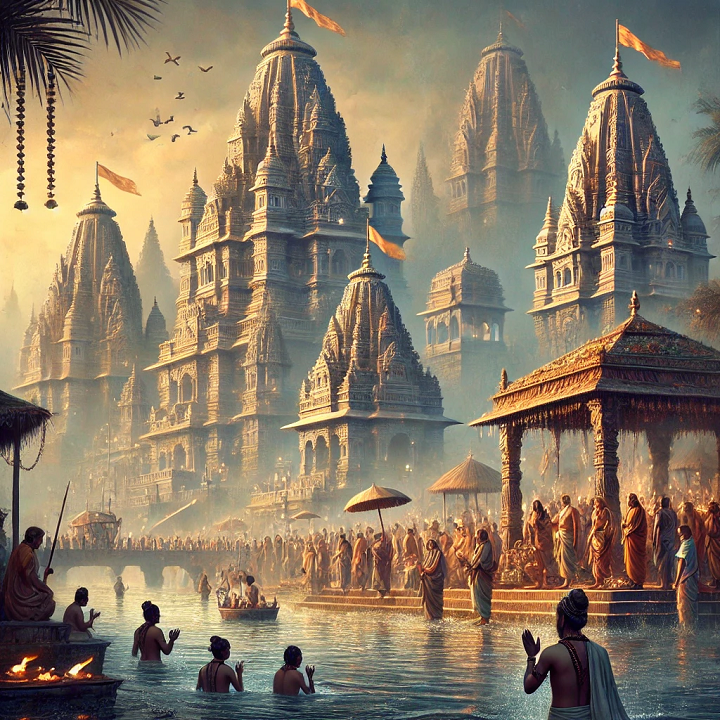कुंभ मेले में घूमने के लिए शीर्ष 10 मंदिर: आध्यात्मिकता, संस्कृति और इतिहास की खोज
कुंभ मेला दुनिया के सबसे बड़े धार्मिक आयोजनों में से एक है, जिसमें लाखों तीर्थयात्री हर साल पवित्र नदियों में स्नान करने और आध्यात्मिक शांति प्राप्त करने के लिए इकट्ठा होते हैं। इस ऐतिहासिक आयोजन का केंद्र होते हैं वह पवित्र मंदिर, जो न केवल धार्मिक आस्था का प्रतीक हैं, बल्कि भारतीय संस्कृति, वास्तुकला और पौराणिक कथाओं से भी गहरे जुड़े हैं। आइए जानते हैं उन शीर्ष 10 मंदिरों के बारे में जो कुंभ मेले के दौरान दर्शनीय हैं।
कीवर्ड्स: कुंभ मेला, पवित्र मंदिर, हरिद्वार, प्रयागराज, नासिक, उज्जैन, आध्यात्मिकता, तीर्थयात्रा, गंगा, यमुना, गोदावरी, क्षिप्रा, हिंदू संस्कृति, धार्मिक स्थल, मंदिर वास्तुकला, पवित्र स्नान, अनुष्ठान, श्रद्धा, ध्यान, पौराणिक कथा।
1. हर की पौड़ी, हरिद्वार: गंगा के किनारे एक पवित्र स्थल
हरिद्वार का हर की पौड़ी कुंभ मेला का प्रमुख स्थल है। यहां पर हर साल लाखों तीर्थयात्री गंगा नदी में स्नान करते हैं, ताकि वे अपने पापों से मुक्त हो सकें। मंदिर की वास्तुकला बेहद साधारण है, लेकिन इसकी आध्यात्मिक महत्ता अत्यधिक है। यहां की शाम की गंगा आरती अत्यधिक दर्शनीय है।
2. प्रयागराज का त्रिवेणी संगम: तीन नदियों का संगम
प्रयागराज का त्रिवेणी संगम एक अद्वितीय स्थल है जहां गंगा, यमुना और पौराणिक सरस्वती नदियां मिलती हैं। यहां पर स्थित काशी विश्वनाथ मंदिर भगवान शिव को समर्पित है, और इसका ऐतिहासिक महत्व भी अत्यधिक है। हर साल कुंभ मेले के दौरान यह स्थान भक्तों से भरा रहता है।
3. कुंभेश्वर मंदिर, नासिक: भगवान शिव का प्राचीन मंदिर
नासिक के कुंभेश्वर मंदिर में भगवान शिव की पूजा की जाती है। यह मंदिर 12वीं सदी में बना था और इसका वास्तुशिल्प उत्तर भारतीय मंदिर शैली का अद्भुत उदाहरण है। कुंभ मेला के दौरान यहां पर तीर्थयात्रियों की भारी भीड़ होती है।
4. महाकालेश्वर मंदिर, उज्जैन: एक ज्योतिर्लिंग स्थल
उज्जैन का महाकालेश्वर मंदिर भगवान शिव का एक प्रमुख ज्योतिर्लिंग है। इसकी वास्तुकला भी अनूठी है और यहां पर विशेष रूप से भस्म आरती का आयोजन होता है। यह मंदिर कुंभ मेला के दौरान एक प्रमुख आध्यात्मिक केंद्र बनता है।
5. सोमनाथ मंदिर, गुजरात: एक समुद्र के किनारे पवित्र स्थल
सोमनाथ मंदिर, जो भगवान शिव के 12 ज्योतिर्लिंगों में से एक है, गुजरात के प्रभास पतन में स्थित है। इसका ऐतिहासिक महत्व अत्यधिक है और यह कुंभ मेला स्थल से सीधे जुड़ा नहीं है, फिर भी श्रद्धालु इसे अपनी यात्रा का हिस्सा बनाते हैं।
6. राम जन्मभूमि, अयोध्या: श्रीराम का जन्मस्थल
अयोध्या में स्थित राम जन्मभूमि मंदिर हिंदू धर्म के सबसे पवित्र स्थलों में से एक है। यह स्थल आगामी कुंभ मेलों के दौरान विशेष रूप से महत्वपूर्ण होगा, क्योंकि यहां पर मंदिर निर्माण कार्य जारी है।
7. सिद्धिविनायक मंदिर, नासिक: गणेश जी का आशीर्वाद
नासिक स्थित सिद्धिविनायक मंदिर भगवान गणेश को समर्पित है। यह मंदिर खासकर नासिक कुंभ मेला के दौरान श्रद्धालुओं से भर जाता है, जो सफलता और समृद्धि की कामना करते हैं।
8. केदारनाथ मंदिर, उत्तराखंड: चार धाम यात्रा का हिस्सा
हालांकि केदारनाथ मंदिर कुंभ मेला के स्थलों में शामिल नहीं है, यह भगवान शिव के प्रमुख तीर्थ स्थलों में से एक है। यहां पर दर्शन करने के लिए श्रद्धालु दूर-दूर से आते हैं।
9. नीलकंठ महादेव मंदिर, ऋषिकेश: एक अद्भुत पर्वतीय स्थल
ऋषिकेश में स्थित नीलकंठ महादेव मंदिर भगवान शिव को समर्पित है और यह कुंभ मेला के दौरान एक महत्वपूर्ण स्थल बनता है। यहां की शांतिपूर्ण वातावरण और पौराणिक कथाएं इसे खास बनाती हैं।
10. विश्वनाथ मंदिर, वाराणसी: गंगा के किनारे शिव का घर
वाराणसी में स्थित विश्वनाथ मंदिर भारत के सबसे पुराने और पवित्र मंदिरों में से एक है। यहां पर हर साल लाखों श्रद्धालु पवित्र स्नान के लिए आते हैं और शिव की पूजा करते हैं।
Top 10 Temples to See During Kumbh Mela: Exploring Spirituality, Culture, and History
Kumbh Mela is one of the largest and most significant religious gatherings in the world. Every few years, millions of pilgrims travel across the globe to bathe in the sacred rivers, be it Ganga in Haridwar, Yamuna in Prayagraj, or Kshipra in Ujjain. At the core of this historical spectacle are the temples that beckon people to it for spiritual regeneration, historical investigation, and cultural assimilation. In this blog, we take you through the top 10 temples to visit during the Kumbh Mela and draw attention to their deep importance.
Har Ki Pauri, Haridwar
Located on the banks of the Ganga, Har Ki Pauri is one of the most sacred sites in India. This temple is a key landmark during the Haridwar Kumbh Mela. The name "Har Ki Pauri" translates to "The Footsteps of Lord Shiva," and the temple holds immense historical and spiritual importance. Pilgrims flock to this temple to take a holy dip in the Ganga, believed to cleanse one’s sins. The architecture, though simple, holds immense significance, and the evening Ganga Aarti here is a mesmerizing spiritual experience.
Triveni Sangam, Prayagraj
The confluence of three rivers-Ganga, Yamuna, and the mythical Saraswati-is where the Kumbh Mela of Prayagraj takes place. The Triveni Sangam is a sacred place where devotees gather to perform rituals and take a holy dip. The most important temple in Prayagraj is the Kashi Vishwanath Temple, dedicated to Lord Shiva. Devotees come here to seek blessings for peace and prosperity. The temple's architectural grandeur and its history dating back to the 11th century make it an important spiritual center during the Kumbh.
Kumbheshwar Temple, Nashik
Nashik, on the banks of the Godavari, is another significant venue for the Kumbh Mela. The Kumbheshwar Temple here is dedicated to Lord Shiva and is one of the oldest temples in the region. Built in the 12th century, its architectural style is a combination of North Indian temple architecture with intricately carved stone structures. The temple is part of the Nashik Kumbh Mela, where pilgrims gather to bathe in the Godavari River, believing it will grant salvation.
Mahakaleshwar Temple, Ujjain
Ujjain is one of the holiest cities in India, and during the Ujjain Kumbh Mela, the Mahakaleshwar Temple is the focal point. This temple is Lord Shiva, and the most special feature is its unique architecture and live Bhasma Aarti, held at dawn. The temple was constructed over 1,500 years ago, and it's one of the important pilgrimage places. Shivalinga of this temple is said to be one of the 12 Jyotirlingas, and this is the most significant feature of Hindu mythology.
Somnath Temple, Prabhas Patan, Gujarat
Though not situated directly at the Kumbh Mela sites, the Somnath Temple is one of the twelve Jyotirlingas of Lord Shiva, attracting devotees all through the year. The temple's seaside location and its historical significance as the first among the Jyotirlingas make it a prominent site. The architecture of the temple is rich in carvings, and the ancient tales attached to it make it mystical.
Ram Janmabhoomi, Ayodhya
Ayodhya is the birthplace of Lord Ram, and it has played a significant role in Hindu pilgrimage. The construction of the Ram Janmabhoomi temple is under process, which is going to be one of the most significant spiritual hubs in the country. The presence of this temple at Kumbh Mela makes the atmosphere full of devotion, and its role in the journey of faith that has been ongoing in India for thousands of years is deeply entangled with the history of Hinduism.
Siddhivinayak Temple, Nashik
The Siddhivinayak Temple is located in Nashik and is dedicated to Lord Ganesha. Thousands of devotees visit this temple during the Nashik Kumbh Mela. The temple has a blend of traditional and modern architecture, and its importance is due to its strong connection with the worship of Lord Ganesha. Devotees come here for prosperity and success, and hence, it is a must-visit place during the Kumbh.
Kedarnath Temple, Uttarakhand
Although not connected with the Kumbh Mela, the Kedarnath Temple is one of the primary attractions for devotees. The temple is in the snow-clad mountains of Uttarakhand and is associated with Lord Shiva as a part of Char Dham Yatra. People visit the Kedarnath Temple for peace, divine blessings, and spiritual progress and is always an icon of faith during the Kumbh Mela time.
Neelkanth Mahadev Temple, Rishikesh
The Neelkanth Mahadev Temple is situated in Rishikesh, which is known for its spiritual atmosphere and the famous Laxman Jhula. Located on a hilltop, this temple dedicated to Lord Shiva is one of the most popular stops for pilgrims during the Haridwar Kumbh Mela. The temple is located in a serene place and is associated with the mythological churning of the ocean, making it a spiritually significant site.
Vishwanath Temple, Varanasi
The Vishwanath Temple in Varanasi is dedicated to Lord Shiva and is one of the most revered and ancient temples in India. The temple, dating back to the 11th century, is located on the banks of the Ganga. Thousands of pilgrims visit during the Kumbh Mela at Varanasi to perform rituals, take a holy dip, and offer prayers at this sacred site. The temple's unique architecture and its connection to the river enhance its divine appeal.

